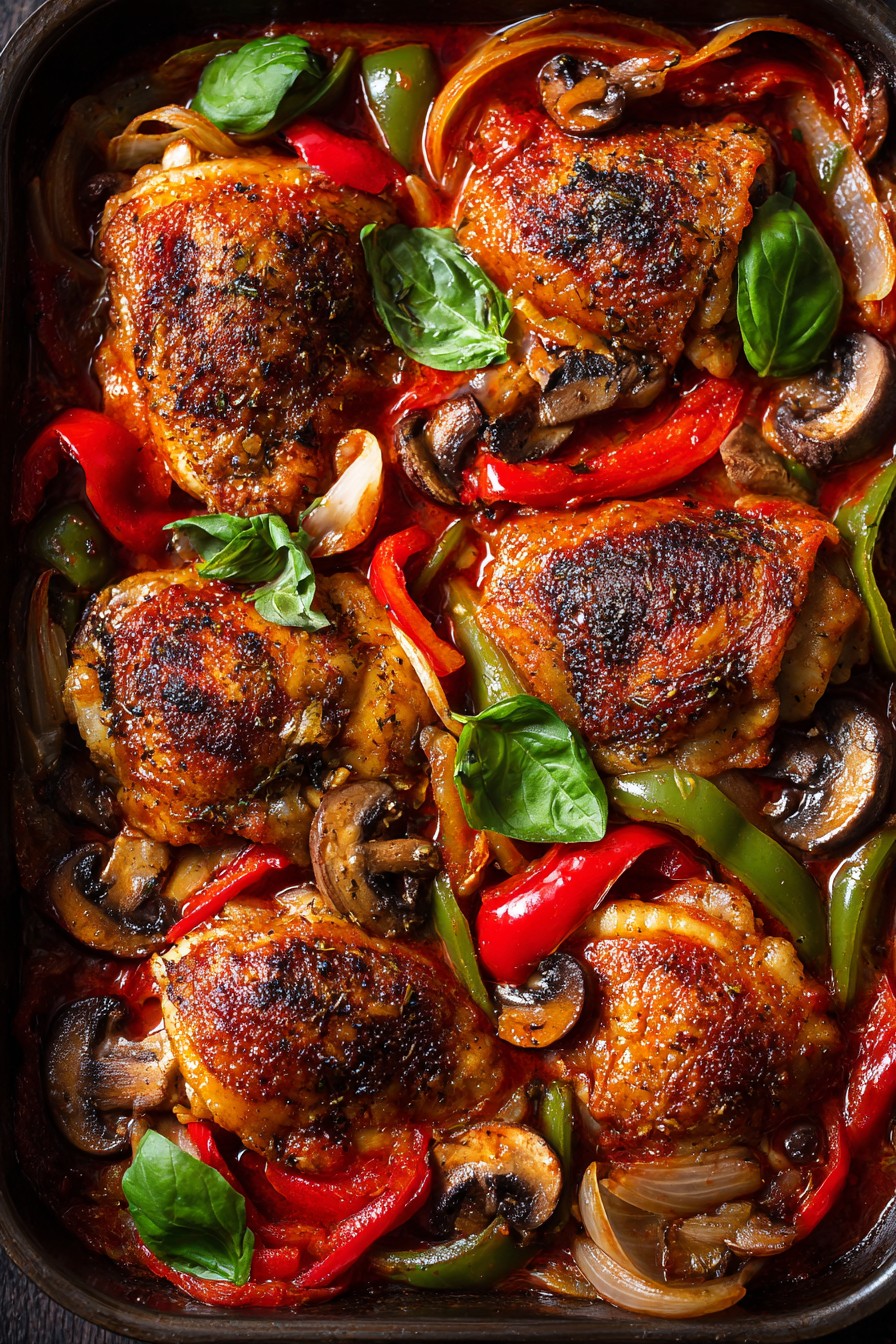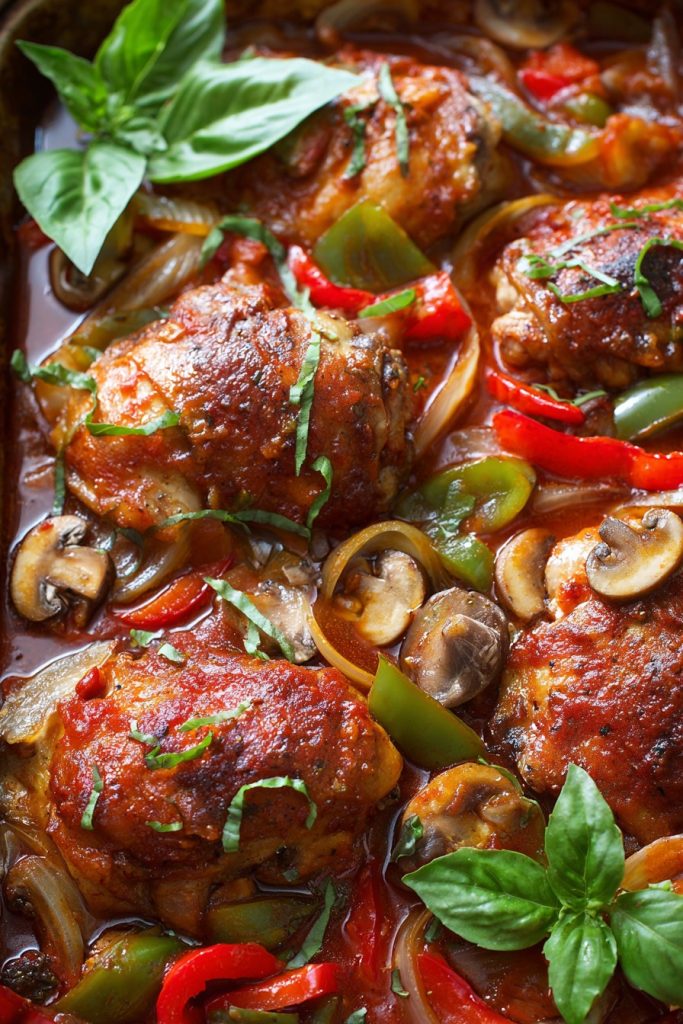Buckle up, flavor lovers! Because today we’re diving into the ultimate comfort food that’ll make your kitchen smell like a rustic Italian trattoria. This baked chicken cacciatore is about to become your new go-to dinner that’s equal parts impressive and ridiculously easy to pull off.
Why This Recipe Works
- Baking instead of stovetop cooking allows all the flavors to meld together beautifully while keeping the chicken incredibly moist and tender throughout the cooking process
- The one-pan method means minimal cleanup and maximum flavor development as the chicken juices mingle with the vegetables and herbs
- Using both fresh and canned tomatoes creates a perfect balance of bright acidity and deep, cooked-down richness in the sauce
- The combination of herbs including oregano, basil, and thyme provides layers of aromatic complexity that elevate this dish beyond ordinary chicken recipes
- Baking at 375°F ensures the chicken cooks through without drying out while allowing the vegetables to become perfectly tender without turning to mush
Ingredients
- 4 bone-in, skin-on chicken thighs (about 2 pounds total)
- 4 bone-in, skin-on chicken drumsticks (about 1.5 pounds total)
- 2 tablespoons olive oil, divided
- 1 large yellow onion, thinly sliced
- 1 red bell pepper, sliced into 1/2-inch strips
- 1 green bell pepper, sliced into 1/2-inch strips
- 8 ounces cremini mushrooms, sliced
- 4 cloves garlic, minced
- 1 cup dry white wine (such as Pinot Grigio)
- 1 can (28 ounces) crushed tomatoes
- 1 can (14.5 ounces) diced tomatoes, undrained
- 2 tablespoons tomato paste
- 1 teaspoon dried oregano
- 1 teaspoon dried basil
- 1/2 teaspoon dried thyme
- 1/2 teaspoon red pepper flakes (optional)
- 1 teaspoon kosher salt
- 1/2 teaspoon black pepper
- 1/4 cup fresh basil leaves, chopped
- 2 tablespoons fresh parsley, chopped
Equipment Needed
- Large oven-safe skillet or Dutch oven (at least 12 inches)
- Cutting board and sharp knife
- Measuring cups and spoons
- Mixing bowls
- Tongs
- Wooden spoon
- Aluminum foil (optional)
Instructions

Preheat and Prepare the Chicken
First things first, let’s get that oven preheated to 375°F because we want it nice and hot when our chicken is ready to bake. While that’s heating up, pat your chicken pieces completely dry with paper towels – this is crucial for getting that beautiful golden brown color rather than steamed chicken skin. Season both sides generously with kosher salt and black pepper, making sure every nook and cranny gets some love. Heat 1 tablespoon of olive oil in your large oven-safe skillet over medium-high heat until it shimmers and easily coats the bottom of the pan. Carefully place the chicken pieces skin-side down and resist the urge to move them around for a good 6-8 minutes until the skin is deeply golden brown and crispy. Flip and cook for another 3-4 minutes on the other side until lightly browned, then transfer to a plate while we work on our vegetables.
Sauté the Vegetables
Reduce the heat to medium and add the remaining tablespoon of olive oil to the same skillet – all those delicious chicken drippings are about to work their magic. Toss in your sliced onions and bell peppers and cook for about 5-7 minutes, stirring occasionally, until they begin to soften and the onions turn translucent. Add the sliced mushrooms and continue cooking for another 5 minutes until they release their moisture and start to brown slightly around the edges. Now add the minced garlic and cook for just 30-60 seconds until fragrant – be careful not to burn it or you’ll get bitter notes in your sauce. Pour in the white wine to deglaze the pan, scraping up all those browned bits from the bottom with your wooden spoon, and let it simmer for about 2-3 minutes until reduced by half.
Build the Sauce
Time to create that incredible cacciatore sauce that’ll have everyone asking for seconds! Add the tomato paste to the skillet and cook for about 1 minute, stirring constantly, until it darkens slightly and becomes fragrant. This step helps cook out the raw tomato flavor and deepens the overall taste of your sauce. Pour in both the crushed and diced tomatoes with their juices, then add all your dried herbs – oregano, basil, thyme, and red pepper flakes if using. Season with another teaspoon of salt and give everything a good stir to combine. Let the sauce simmer for about 5-7 minutes until it thickens slightly and the flavors start to come together beautifully. Taste and adjust seasoning if needed – remember, we’ll be adding fresh herbs at the end for brightness.
Combine and Bake
Nestle the browned chicken pieces back into the skillet, skin-side up, making sure they’re partially submerged in the sauce but the crispy skin remains above the liquid line. If your skillet isn’t large enough, you can transfer everything to a 9×13 inch baking dish at this point. Carefully place the skillet in your preheated 375°F oven and bake uncovered for 35-45 minutes. You’ll know it’s ready when the chicken reaches an internal temperature of 165°F on an instant-read thermometer and the sauce is bubbling around the edges with little pockets of oil forming on the surface. The chicken should be fork-tender and practically falling off the bone while the vegetables become meltingly soft in the rich tomato sauce.
Finish and Serve
Carefully remove the skillet from the oven – remember that handle is HOT – and let it rest for about 5-10 minutes before serving. This resting time allows the chicken to reabsorb some juices and makes it easier to handle. While it’s resting, chop your fresh basil and parsley. Just before serving, sprinkle the fresh herbs over the top for that burst of freshness and color that takes this dish from great to absolutely phenomenal. Serve directly from the skillet family-style with crusty bread for dipping into that incredible sauce, or over pasta, polenta, or mashed potatoes for a complete meal that’ll have everyone coming back for more.
Tips and Tricks
If you want to take your cacciatore to the next level, consider browning some pancetta or bacon in the skillet before cooking the chicken and using that rendered fat instead of olive oil for an extra layer of smoky, porky goodness. For an even deeper flavor profile, you can roast your own tomatoes instead of using canned – simply halve Roma tomatoes, toss with olive oil, salt, and pepper, and roast at 400°F for about 30-40 minutes until caramelized and concentrated. When selecting chicken, bone-in, skin-on pieces are non-negotiable for this recipe as they provide far more flavor and stay juicier during the longer baking time compared to boneless, skinless cuts.
If you’re short on time, you can skip browning the chicken and simply place raw seasoned chicken directly into the sauce before baking, though you’ll miss out on that beautiful color and extra flavor from the Maillard reaction. For a richer sauce, stir in a tablespoon of butter or a splash of heavy cream at the end before adding the fresh herbs – this creates a velvety texture that’s absolutely divine. If your sauce seems too thin after baking, you can remove the chicken and reduce the sauce on the stovetop for a few minutes until it reaches your desired consistency. Conversely, if it’s too thick, stir in a splash of chicken broth or water to loosen it up.
This dish actually improves in flavor if made a day ahead – simply cool completely, refrigerate, and reheat gently in a 350°F oven for about 20-25 minutes until heated through. The extended time allows the flavors to meld even more beautifully. Don’t skip the fresh herbs at the end – they provide a crucial bright contrast to the rich, cooked sauce. If you’re feeding a crowd, this recipe doubles easily in a large Dutch oven or roasting pan. Leftovers make incredible pasta sauce or can be shredded for chicken sandwiches the next day.
Recipe Variations
- For a heartier version, add 1 cup of sliced Italian sausage or meatballs during the vegetable cooking stage – the additional meat will make the dish even more substantial and perfect for feeding hungry families. Brown the sausage first before adding the vegetables to develop maximum flavor.
- Create a seafood cacciatore by substituting the chicken with firm white fish fillets like cod or halibut, or a mix of shrimp, scallops, and mussels. Add the seafood during the last 10-15 minutes of baking time to prevent overcooking, and use fish stock instead of wine if preferred.
- For a vegetarian twist, replace the chicken with portobello mushroom caps or large cauliflower steaks. Increase the vegetable quantity and add cannellini beans or chickpeas for protein. Use vegetable broth instead of wine if desired, and consider adding a Parmesan rind to the sauce for extra umami depth.
- Make it spicy by increasing the red pepper flakes to 1 teaspoon and adding 1-2 chopped jalapeños with the bell peppers. You can also stir in a tablespoon of Calabrian chili paste or your favorite hot sauce when building the sauce for an extra kick that warmth lovers will appreciate.
- For a creamier version, stir in 1/2 cup of heavy cream or coconut milk during the last 5 minutes of baking, and top with grated Parmesan cheese before serving. This creates a richer, more indulgent sauce that’s perfect for special occasions or when you need some extra comfort food therapy.
Frequently Asked Questions
Can I use boneless, skinless chicken breasts instead?
While you technically can use boneless, skinless chicken breasts, I wouldn’t recommend it for this particular recipe. The bone-in, skin-on chicken thighs and drumsticks provide much more flavor and stay incredibly moist during the longer baking time. Boneless breasts tend to dry out and become tough when cooked this way. If you must use them, reduce the baking time to 25-30 minutes and check the internal temperature early to prevent overcooking.
What can I substitute for the white wine?
If you prefer not to use wine, you can substitute with an equal amount of chicken broth mixed with 1 tablespoon of white wine vinegar or lemon juice to mimic the acidity. Alternatively, you can use vegetable broth or even water in a pinch, though the flavor will be less complex. The wine adds depth and helps deglaze the pan, so if omitting, make sure to scrape those browned bits thoroughly with your liquid of choice.
How should I store leftovers and how long do they keep?
Leftovers can be stored in an airtight container in the refrigerator for up to 4 days. The flavors actually improve overnight as they continue to meld together. Reheat gently in a saucepan over medium-low heat or in the microwave, stirring occasionally. You can also freeze the cacciatore for up to 3 months – cool completely, transfer to freezer-safe containers, and thaw in the refrigerator overnight before reheating.
Can I make this recipe in a slow cooker?
Absolutely! For slow cooker adaptation, brown the chicken and vegetables as directed in a skillet first to develop flavor, then transfer everything to your slow cooker. Cook on low for 6-8 hours or high for 3-4 hours. The chicken will be fall-off-the-bone tender, though the skin won’t stay crispy. If you prefer crispy skin, you can broil the chicken for a few minutes after cooking before serving.
What should I serve with chicken cacciatore?
This dish is incredibly versatile when it comes to accompaniments. Traditional pairings include pasta like pappardelle or spaghetti, creamy polenta, or mashed potatoes to soak up the delicious sauce. Crusty bread is essential for dipping, and a simple green salad with vinaigrette provides a fresh contrast. For a low-carb option, try serving over cauliflower mash or zucchini noodles.
Summary
This baked chicken cacciatore delivers incredible flavor with minimal effort, featuring tender chicken in a rich tomato sauce with peppers, mushrooms, and herbs. Perfect for family dinners or entertaining, it’s a one-pan wonder that tastes even better the next day.
Baked Chicken Cacciatore
5
servings20
minutes55
minutesIngredients
Instructions
- 1 Preheat oven to 375°F. Season chicken with salt and pepper. Brown in 1 tablespoon oil, skin-side down first, then transfer to plate.
- 2 Sauté onions, peppers, then mushrooms in remaining oil. Add garlic and cook until fragrant.
- 3 Deglaze with wine, then add tomato paste, canned tomatoes, and dried herbs. Simmer for 5-7 minutes.
- 4 Nestle chicken into sauce, skin-side up. Bake at 375°F for 35-45 minutes until chicken reaches 165°F.
- 5 Rest for 5-10 minutes, then garnish with fresh herbs before serving.



